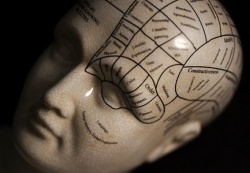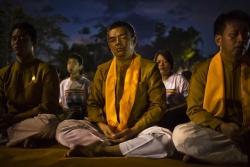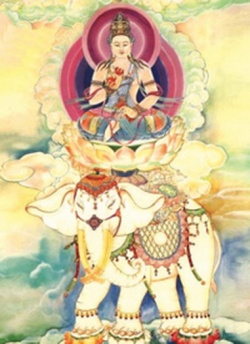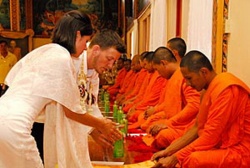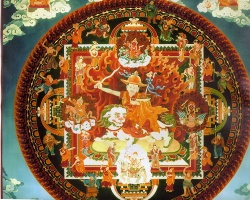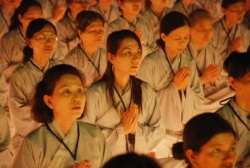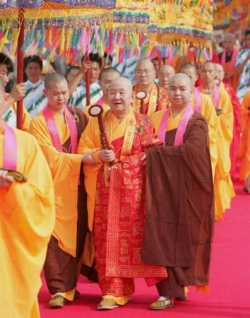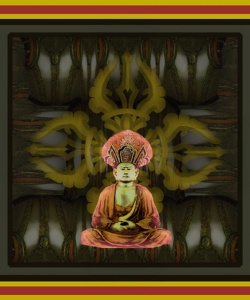Directly Experience the Nature of Mind
by Khenchen Thrangu Rinpoche
Khenchen Thrangu Rinpoche is a teacher in the Karma Kagyü lineage. His main residence is his monastery in Boudhanath, Nepal. He is the founder of a monastic college at Namo Buddha near Kathmandu and of many Buddhist centers in the West and Asia.
Instruction on Mahamudra vipashyana meditation by Khenchen Thrangu Rinpoche
The two meditation practices of shamatha and vipashyana each have their place within Mahamudra practice, but they do not have the same objective. Shamatha’s aim is temporary, immediate. When our minds are disturbed or restless, they are not at peace. Cultivating the settled state of shamatha, we find that we are able to be more steady, more tranquil. That is the purpose of shamatha. Shamatha is not sufficient unto itself to attain enlightenment, but it is a support for Mahamudra practice and is therefore imperative.
What then is vipashyana, which literally means “clear seeing,” in the context of Mahamudra? First of all, we have bewildered ourselves into samsara. During this confused state, we do not see clearly the true nature of things, what reality is. The practice of vipashyana develops the ability to see clearly the actual state of affairs, to see the basic condition of what is. Training in vipashyana eliminates negative emotions and clarifies our lack of knowing, our ignorance. It also deepens our insight and wisdom.
Right now, while adrift on samsara’s ocean, we are confused about what is real, about the nature of things. In this state, there are many worries and a lot of fear and uneasiness. To be free of these we need to be free of the bewilderment and confusion. When you are free of confusion, the uneasiness, worry and fear evaporate all by themselves. For example, if there is a
rope lying on the ground and someone mistakes it for a poisonous snake, he will be frightened. He worries about the snake and it creates a lot of anxiety. This uneasiness continues until he discovers that it is actually not a snake,
but simply a rope. It was merely a mistake. The moment we realize the rope is just a rope, not a snake, our uneasiness, fear and anxiety disappear. In the same way, upon seeing the natural state of what is, all the suffering, fear and confused worries that we are so engrossed in will disappear. The focal point of vipashyana training is seeing what is real.
The Paths of Reasoning and Direct Perception
The pivotal difference between the path of reasoning and the path of direct perception is whether our attention faces out, away from itself, or whether the mind faces itself, looking into itself. The path of reasoning is always concerned with looking at something “out there.” It examines using the power of reason until we are convinced that what we are looking at is by nature empty, devoid of an independent identity. Whether on a coarse or subtle level, it is definitely empty. However, no matter how long and how thoroughly we convince ourselves that things are by nature empty, every time we stub our toe on something it hurts. We are still obstructed; we cannot move our hands
straight through things, even though we understand their emptiness. The path of reasoning alone does not dissolve the mental habitual tendency to experience a solid reality that we have developed over beginningless lifetimes.
It is not that a particular practice transforms the five aggregates—forms, sensations, perceptions, formations and consciousnesses—into emptiness. Instead it is a matter of acknowledging how all phenomena are empty by nature. This is how the Buddha taught in the sutras. A person presented with such a teaching may often understand the words and
trust the teachings, but personally he does not experience that that is how it really is. Nagarjuna kindly devised the Middle Way techniques of intellectual reasoning in order to help us understand and gain conviction. By analyzing the five aggregates one after the other, one eventually is convinced, “Oh, it really is true! All phenomena actually areempty by nature!”
While we use many tools to reach such an understanding, the reasoning of dependent origination is very simple to understand. For example, when standing on one side of a valley you say that you stand on “this” side, and across the valley is the “other” side. However, if you walk across the valley you will again describe it as “this” side, though it was the “other” side before. In
the same way, when comparing a short object to a longer one, we agree that one is shorter and the other longer. Nevertheless, that is not fixed because if you compare the longer one to something even longer, it is then the shorter one. In other words, it is impossible to pin down a reality for such values; they are merely labels or projections created by our own minds.
We superimpose labels onto temporary gatherings of parts, which in themselves are only other labels superimposed on a further gathering of smaller parts. Each thing only seems to be a singular entity. It appears as if we have a body and that there are material things.
Yet, just because something appears to be, because something is experienced, does not mean that it truly exists. For example, if you gaze at the ocean when it is calm on a clear night you can see the moon and stars in it. But if you sent out a ship, cast nets and tried to gather up the moon and stars, would you be able to? No, you would find that there is nothing to catch.
That is how it is: things are experienced and seem to be, while in reality they have no true existence. This quality of being devoid of true existence is, in a word, emptiness. This is the approach of using reasoning to understand emptiness.
Using reasoning is not the same as seeing the emptiness of things directly and is said to be a longer path. Within the framework of meditation, the intellectual certainty of thinking that all things really are emptiness is not a convenient
method of training; it takes a long time. That is why the Prajnaparamita scriptures mention that a Buddha attains true and complete enlightenment after accumulating merit over three incalculable eons. Yet, the Vajrayana teachings declare that in one body and one lifetime you can reach the unified level of a vajra-holder; in other words, you can attain complete enlightenment in this very life. Though they would appear to contradict each other, both statements are true. If one uses
reasoning and accumulates merit alone, it does take three incalculable eons to reach true and complete enlightenment. Nevertheless, by having the nature of mind pointed out to you directly and taking the path of direct perception, you can reach the unified level of a vajra-holder within this same body and lifetime.
Taking direct perception as the path, using actual insight, is the way of the mind looking into itself. Instead of looking outward, one turns the attention back upon itself. Often we assume that mind is a powerful and concrete “thing” we walk around with
inside. But in reality it is just an empty form. When looking into it directly to see what it is, we do not need to think of it as being empty and infer emptiness through reasoning. It is possible to see the emptiness of this mind directly.
Instead of merely thinking of it, we can have a special experience—an extraordinary experience—and discover, “Oh, yes, it really is empty!” It is no longer just a conclusion we postulate. We see it clearly and directly. This is how the great masters of India and Tibet reached accomplishment.
Instead of inferring the emptiness of external phenomena through reasoning, the Mahamudra tradition taught by Tilopa, Naropa, Marpa and Milarepa shows us how to directly experience emptiness as an actuality. Since we
habitually perceive external objects as always having concrete existence, we do not directly experience them as being empty of true existence. It is not very practical to become convinced of the emptiness of external objects such as mountains, houses, walls, trees, and so forth. Instead, we should look into our own mind. When we truly see our mind’s
nature, we find it has no concrete identity whatsoever. This is the main point of using direct perception: look directly into your own mind, see in actuality that it is empty, and then continue training in that.
This mind, the perceiver, does experience a variety of moods. There are feelings of being happy, sad, exhilarated, depressed, angry, attached, jealous, proud or close-minded; sometimes one feels blissful, sometimes
clear or without thoughts. A large variety of different feelings can occupy this mind. However, when we use the instructions and look into what the mind itself really is, it is not very difficult to directly perceive the true nature of mind. Not only is it quite simple to do, but it is extremely beneficial as well.
We usually believe that all of these different moods are provoked by a material cause in the external environment, but this is not so. All of these states are based on the perceiver, the mind itself. Therefore, look into this mind and discover that it is totally devoid of any concrete identity. You will see that the mental states of anger or attachment, all the mental poisons, immediately subside and dissolve—and this is extremely beneficial.
To conclude this section, I will restate my previous point. On the one hand, we hear that to awaken to true and complete enlightenment, it is necessary to perfect the accumulations of merit through three incalculable eons. Then on the other hand, we hear that it is possible to attain the unified level of a vajra-holder within this same body and lifetime. These
two statements appear to contradict one another. Truthfully, there is no way one could be enlightened in one lifetime if one had to gather accumulations of merit throughout three incalculable eons. However, if one could be enlightened in a single lifetime then there seems to be no need to perfect the accumulation of merit throughout three incalculable eons.
Actually, both are right in that it does take a very long time if one takes the path of reasoning. Whereas it is possible to attain enlightenment within a single lifetime if one follows the tradition of the pith instructions, using direct perception as the path.
Establishing the Identity of Mind and the Various Perceptions
It should be clear now that our use of the term vipashyana refers to direct perception. To attain this direct perception, we must undertake two tasks: first, gain certainty about the identity of mind; second, gain certainty about the identity of mind’s expression, which includes thought and perceptions. Put another way, we need to investigate three aspects: mind, thought and perception.
The first of these—mind—is when one is not involved in any thoughts, neither blatant thought states nor subtle ones. Its ongoing sense of being present is not interrupted in any way. This quality is called cognizance, or salcha in Tibetan.
Salcha means there is a readiness to perceive, a readiness to think, to experience, that does not simply disappear. Since we do not turn to stone or into a corpse when we are not occupied by thinking, there must be an ongoing continuity of mind, an ongoing cognizance.
Next are thoughts, or namtok. There are many different types of thoughts, some subtle, like ideas or assumptions, and others quite strong, like anger or joy. We may think that mind and thoughts are the same, but they are not.
The third one, perceptions, or nangwa, actually has two aspects. One is the perception of so-called external objects through seeing, hearing, smelling, tasting and touch. Let us set those aside for the time being, though, as they are not
the basis for the training at this point. The other aspect of perception deals with what occurs to the sixth consciousness: mental images. These mental impressions are not perceived through the senses but somehow occur to the mind in the form of
memories, something imagined or thought of. Nevertheless, each of these mental impressions feels as if it is sight, sound, smell, taste or texture. Usually, we do not pay attention to any of this—it just happens and we are caught up in it; for example, when we are daydreaming or fantasizing.
It is important to become clear about what mind, thoughts and perceptions actually are—not in a theoretical way but in actuality. In the past, we may not have paid much attention to mind’s way of being when not occupied with thoughts or perceptions. We may not have looked into what the mind itself—that which experiences or perceives—actually consists of and,
therefore, we may not be certain of it. When there are thoughts, mental images or perceptions, the usual habit is simply to lose control and be caught up in the show. We continually get absorbed in what is going on, instead of taking a good, clear look at the perceiving mind. We tend not to be aware that we are thinking or daydreaming; we
tend to be in a rather vague, hazy state. Meditation training lets these thoughts and mental images become quite vivid. They can become as clear as day. At this point, we should take a good look and in an experiential way personally establish what their actual nature or identity is.
We use the word examine repeatedly. When you establish the nature of things by means of reason, examining refers to intellectual analysis; but that is not what we are talking about now. Unlike an intellectual investigation, examining should be
understood as simply looking at how things actually are.
Establishing the Identity of Mind—the Basis
The Mahamudra sense of vipashyana does not mean to examine concepts, but to look into what the mind actually is, namely a sense of being awake and conscious, continuously present and very clear. Whenever we do look, no
matter when, we cannot help but discover that mind has no form, color or shape—none at all. Then we may wonder, “Does that mean that there is no mind? Does the mind not exist?” If there were no consciousness in the body, the
body would be a corpse. Yet we can see and hear, and we can understand what we are reading—so we are not dead, that’s for sure. The truth is that while mind is empty—it has no shape, color or form—it also has the ability to cognize; it has a knowing quality. The fact is that these two aspects, being empty and able to know, are an indivisible unity.
Mind does exist as a continuing presence of cognizance. We are not suddenly extinct because there are no thoughts; there is something ongoing, a quality of being able to perceive. What exactly is this mind? What does it look like? If mind exists, then in what mode does it exist? Does the mind have a particular form, shape, color and so forth? We should simply take a close look at what it is that perceives and what it looks like, then try to find out exactly what it is.
The second question is, where is this mind, this perceiver, located? Is it inside or outside of the body? If outside, then exactly where? Is it in any particular object? If it is in the body, then exactly where? Does it pervade throughout the body—head, arms, legs, etc.? Or is it in a particular part—the head or torso, the upper part or the lower part? In this way, we investigate
until we become clear about the exact shape, location and nature of this perceiving mind. Then if we do not actually find any entity or location, we may conclude that mind is empty. There are different ways in which something can be empty. It could simply be absent, in the sense that there is no mind. However, we have not totally disappeared; we still perceive and there
is still some experience taking place, so you cannot say that mind is simply empty. Though this mind is empty it is still able to experience. So what is this emptiness of mind?
By investigating in this way, we do not have to find something that is empty or cognizant or that has a shape, color or location. That is not the point. The point is simply to investigate and see it for what it is—however that might be. Whether we discover
that the perceiver is empty, cognizant or devoid of any concreteness, it is fine. We should simply become clear about how it is and be certain—not as a theory, but as an actual experience.
If we look for a perceiver, we won’t find one. We do think, but if we look into the thinker, trying to find that which thinks, we do not find it. Yet, at the same time, we do see and we do think. The reality is that seeing occurs without a seer and thinking without a thinker. This is just how it is; this is the nature of the mind. The Heart Sutra sums this up by saying
that “form is emptiness,” because whatever we look at is, by nature, devoid of true existence. At the same time, emptiness is also form, because the form only occurs as emptiness. Emptiness is no other than form and form is n
o other than emptiness. This may appear to apply only to other things, but when applied to the mind, the perceiver, one can also see that the perceiver is emptiness and emptiness is also the perceiver. Mind is no other than emptiness; emptiness is no other than mind. This is not just a concept; it is our basic state.
The reality of our mind may seem very deep and difficult to understand, but it may also be something very simple and easy because this mind is not somewhere else. It is not somebody else’s mind. It is your own mind. It is right here; therefore, it is something that you can know. When you look into it, you can see that not only is mind empty, it also knows; it is cognizant. All
the Buddhist scriptures, their commentaries and the songs of realization by the great siddhas express this as the “indivisible unity of emptiness and cognizance,” or “undivided empty perceiving,” or “unity of empty cognizance.” No matter how it is described, this is how our basic nature really is. It is not our making. It is not the result of practice. It is simply the way it has always been.
The trouble is that for beginningless lifetimes we have been so occupied with other things that we have never really paid any attention to it—otherwise we would have already seen that this is how it is. Now, due to favorable circumstances, you are able to hear the Buddha’s words, read the statements made by sublime beings, and receive a spiritual teacher’s guidance. As you start to
investigate how the mind is, when you follow their advice, you can discover how mind really is.
Establishing the Identity of Thoughts and Perceptions—the Expression
Having briefly covered establishing the identity of mind, we will now discuss establishing the identity of thoughts and perceptions, which are the expressions of mind. Though
empty of any concrete identity, mind’s unobstructed clarity does manifest as thoughts and perceptions.
Thoughts can be of many types and, in this context, include emotions. The Abhidharma teachings give a list known as the fifty-one mental events. You may have noticed thangka paintings depicting Vajrayogini wearing a garland of fifty-one freshly cut-
off heads to illustrate the need to immediately sever any obvious thoughts that arise. Blatant thoughts include hate, obsessive attachment, compassion and moods such as feeling hazy or very clear. When these arise, either on their own or by us provoking them in order to have something to investigate, we do not need to analyze why we are angry. Instead, immediately upon the arising of
a strong thought or emotion, look into where it is, what its identity is and what it is made of. Also, when it arises you should try to find the direction it came from, and when it subsides, where it goes. Whether it is a thought, emotion, feeling or mood, the principle is the same: look into where it comes from, where it abides and where
it goes. By investigating in this way, you will find that no real “thing” came from anywhere. Right now the feeling, thought or emotion does not remain anywhere, nor does it actually exist in any concrete way, and, finally, no “thing” actually disappears.
No matter what the thought or emotion may be, we should look into it. But we will fail to find any “thing”—we can’t find where it is, what it looks like or what it is made of.
This failure is neither because we are incapable of looking nor because we have been unsuccessful in finding it, but simply because any movement of the mind is empty of a concrete identity. There is no substance to
it, whether it is anger, fear, joy or sorrow—all are merely empty movements of the mind. We discover that looking into thoughts is no different from looking into the quiet mind. The identity of calm mind is empty cognizance and when we look into a thought movement, we also see an empty cognizance. The great masters of
the past phrased it like this: “Look into the quiet mind when quiet and look into the moving mind when moving.” We discover that mind and thoughts—thebasis and the expression—have the same identity: empty cognizance.
The same holds true for sensory perceptions and memories. The Buddhist teachings define two aspects of reality: relative truth and ultimate truth. From the relative point of view, we cannot deny that there are mental images and memories,
but from thepoint of view of the ultimate truth, we are forced to admit that they do not exist. This appears to be a contradiction. However, while experientially such images do occur to us, when we investigate what they really are, there is no thing to find, no location for them, and no identity or substance from which they are made.
You might wonder what is the use of understanding that our thoughts and perceptions are all by nature empty of any concrete identity. Sometimes we get so happy. It feels so wonderful and we love it; we cling wholeheartedly to whatever we experience or whatever we think of. At other times it is very painful and we feel like
we can’t take it. This is simply due to attaching some solid identity to our thoughts and perceptions. These experiences are not so overwhelming once we clearly see the reality of these thoughts and perceptions—that their identity is not real or concrete. They become much lighter and do not weigh us down so
much anymore. That is the immediate benefit. The lasting benefit is that our experience and understanding of the natural state of mind becomes clearer and clearer, more and more stable.
In this method, we do not become clear about what mind, thoughts and mental impressions are by intellectually building a theory of what they must be like and then forcing our experience to agree with our preconceived ideas. Instead, we go about
it in an experiential way. We simply allow mind, thoughts or mental perceptions to be whatever they are and then look at them, investigate them. With no need to maintain any set notions about how they must be and forcing them to fit such a description, simply take a close look at the situation as it is. This is neither very complicated nor strenuous, because you are not looking into something other, but
rather into this very mind that you already have right here. All you need to do is look at what it actually is. You do not have to
imagine any inaccessible thoughts; simply look at your available thoughts and emotions, investigate where they are and what they are made of. The same goes for any mental impressions—simply investigate what they are as they occur. That is the training. Please spend some time giving mind, thoughts and mental impressions a close look and establish some certainty about what they actually are.
Here we have dealt with establishing the identity of mind, thoughts and mental impressions. We could have decided that mind, thoughts and mental impressions are empty, or perhaps not empty. Either way, in the context of Mahamudra training, one should not create any ideas about them. Instead, one should get to know them
as they are, without any concepts as handles, by simply looking closely into them. One should not try to infer their nature, but rather see what the nature of mind, thoughts and perceptions actually is through direct experience. When we
speak of “establishing their nature” or “cutting through misconceptions about mind, thoughts and perceptions,” therefore, we are referring to attaining clarity or certainty through personal experience. It means to see for ourselves, without any preconceived ideas.
This teaching was adapted from Crystal Clear: Practical Advice for Meditators, by Khenchen Thrangu Rinpoche. Translated by Erik Pema Kunsang. Compiled and edited by Michael Tweed. Published by Rangjung Yeshe Publications, 2003.
